| Heavy Tanks of the JS Series |
|---|
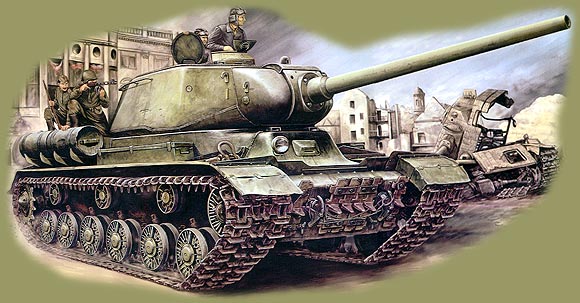
In February of 1944 all existing heavy breakthrough tank regiments, which were equipped with KV tanks, were re-equipped according to the new TO&E. Simultaneously, some new units were formed. These units were equipped with the newest JS tanks. During formation they received "Guards" status (in advance of their combat inmortance). According to TO&E, these regiments (each with 375 men in total) consisted of: four tank companies of 21 tanks (5 tanks per company plus one commander's tank), an SMG infantry company called "tankodesantniki" (infantry which ride on tanks), one antia-ircraft battery, a sapper platoon, a medical platoon and a signal platoon. A feature of the JS tank was that each crew consisted of two officers (lieutenants): a tank commander and a driver. Another two members held the rank of sergeant: a loader and a gunner. Unfortunately, not all crewmen had fought in heavy tanks (KVs and Churchills) before. Many tankers didn't have any experience and came from tank schools, sometimes after additional courses. One of the first units involved in battle was the 13th Guards Heavy Breakthrough Tank Regiment. By February 15, 1944, that regiment arrived in the region of Fastov - Belaya Tzerkov' with 21 JS-1 tanks. It was ordered to support the 109th Tank Brigade in an assault on Lisyanka village (Ukraine). This fighting took place during the Korsun-Shevcheskovsk Operation. The 109th Tank Brigade was an element of 16th Tank Corps which was attached to the 2nd Tank Army. This Army fought against the German 3rd Panzer Corps. A commander of the 13th Regiment detached one company of 5 JS-1's and sent them into action. At that moment all the tanks of 109th Brigade were knocked out by German Panthers and assault guns camouflaged somewhere in the village. Soviet tanks approached within 600-700 metres, when the Germans opened fire. All the Soviet tanks were knocked-out; two of them were burned out. Each of the JS's received up to 7 hits. The next day Lisyanka was encircled and liberated. The Russians captured 16 abandoned Panthers, 2 Pz-IV and 2 StuG-40. They were abandoned after running out of fuel. On March 15, 1944, fifteen JS-1's from the 13th Guards Heavy Breakthrough Tank Regiment were supporting an attack of 50th Tank Brigade near the Uman'. During that battle, five JS-1 were destroyed by German 88 mm Flak guns. Three tanks failed due to technical breakdowns, and one tank fell into a river (near Polkovnichie). During that battle a rare incident occurred: the lower frontal armor of an JS-1 was penetrated by a German Pz.B-41 anti-tank rifle. |
The first verified engagement between JS-1's and Tigers I occurred on the 4th of March, 1944 near the Staro-Konstantinov (Ukraine). During the Proskurovsko-Chernovitsky offensive operation the 1st Guards Heavy Breakthrough Tank Regiment (of Colonel N.I.Bulanov) was involved in a battle with a company of Tigers of the 503rd PzAbt. One of the JS-1's was destroyed from a range of between 1500 and 1800 metres and another two were damaged in various ways though were capable to move. The main gun of one of the Tigers was also damaged in the engagement. Another Tiger received heavy damage in the chassis. On March 16 of 1944, several Tigers ambushed a company of JS-1's. Two of the Soviet tanks were burned out with their crews. During 8 March, on a number of occasions, a couple of JS-1's were destroyed by a battery of 75 mm PaK 40's from the lethally short distance of 150-200 metres. The first JS received 8 hits and the second tank - 4 hits. |
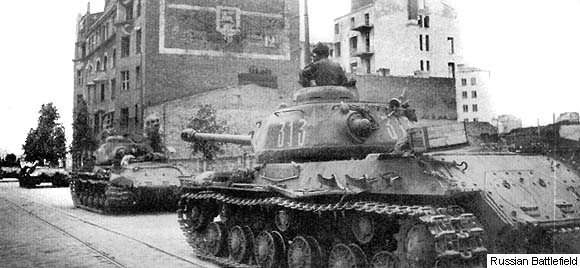
Analyzing the results of those battles, the GBTU came to the conclusion that the armament and protection of the JS-1 didn't correspond to its intended tasks and was inferior to the German heavy tanks. GBTU recommended increased armor protection and rearming the JS-1 with a more powerful weapon. The JS-2 tank happened much more dangerous to German tanks because the 122 mm D-25T gun had better armour-penetration than the 85 mm D-5T. Furthermore, its fragmentation and high explosive ammunition was also quite effective against armored targets. Like the JS-1, the JS-2s had their "baptism of fire" during the final stage of liberation of the right-bank Ukraine. It is necessary to remind readers that the first time the JS-2 saw the action was not in the Korsun-Chevchenkovskaya operation, but in the subsequent battles: Proskurovo-Tchernigovskaya and Umansko-Botochskaya operations. On the two regiments (11th and 72nd Independent Guards Heavy Tank Regiments) equipped with these tanks the most successful was the 72nd Regiment, especially during the period from 20 of April to 10 of May 1944. During that period, the Regiment was incorporated to the 1st Guards Tank Army and took part in actions near Obertin (Ivano-Frankovsky region). After 20 days of non-stop fighting, they lost only eight JS-2s, the Regiment destroyed forty one Tiger I and Elephants/Ferdinands (this is according to some After Battle Report, but more likely there were StuGs, not Ferdinands) , 3 ammunition carriers and 10 anti-tank guns. The most significant information about JS-2 capabilities is given in a Tank Damage Report of that period: |
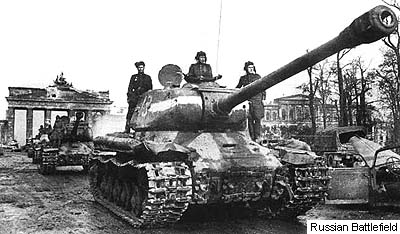 JS-2 tanks entering Berlin, 1945. |
"The 20 of April, tank #40247 came under fire from a self-propelled gun "Ferdinand" from a range of 1500-2000 metres. The tank-crew could fire only one shot because of the faulty firing mechanism. Manoeuvring to get away from the fire of self-propelled gun, JS-122 received, without any damage, 5 hits on the frontal plate. Meanwhile another unseen "Ferdinand" approached from the flank at a distance of 600-700 metres and perforated close to the right side of the engine compartment with an armor-piercing round. The crew left the immobilized tank, which burnt suddenly.
Tank #40255 received a direct hit by a 88 mm round of "Tiger" in the frontal lower plate at a the distance of 1000-1100 metres. Because of that, the left fuel tank was penetrated and the driver was wounded by a fragment of armour. The rest of the crew received light burns. The tank was burnt out.
After receiving three shots from the 88 mm Tiger's rounds on the nose from a distance of 1000-1500 metres, tank #4032 was destroyed by fire from another Tiger some 400-500 metres away. An 88 mm armor-piercing round penetrated the sloped armor plate from the right side. First the shell-case charges ignited, and then the fuel. The crew left the tank and evacuated the driver to the rear.
After being holed by 88 mm round of a "Tiger", from the distance 400 metres, on the frontal armor; the tank #4033 was towed to the to a repair facility for repair.
Tank #40260 was burned out after receiving a 88 mm round from a "Tiger", which fired at the left side from the flank at a range of 500 metres. The round damaged the engine and the tank ignited. The commander and the driver were wounded.
Tank #40244 received a hit from an 88 mm armor-piercing round fired by a "Tiger". The hit was received at the close range of 800-1000 metres in the right side of the hull. The driver died and the diesel fuel from damaged right fuel tank ignited. The tank was evacuated and blown up by sappers.
Tank #40263 caught fire after two rounds hit its side.
Tank #40273 was on its own, apart from the Regiment, and the 30 of April, near Iggisk, received two direct hits: the first in the turret and, immediately after, the second in the side plate of the engine compartment. The crew in the turret died at once, and the driver was wounded. The tank was left in enemy territory. During the combat, the tank crew participated in the repulse of the attack of 50 T-IIIs, T-IVs and T-VIs [the Russian term for Pz-III, Pz-IV, Pz-VI - Valera P.] which were supported by artillery and air attacks.
Tank #40254 was damaged from a distance of 800-1000 metres, by a "Ferdinand" in ambush. The first round did not penetrate the turret ring, but the second round put the engine out of order. The crew was evacuated and the tank was burnt out on the battle field.
Tank #40261 received a direct hit into the gun barrel. After the combat the barrel was changed for a new one."
[Please note: although the Russians often confused StuG with the Ferdinand, in this report the Ferdinand was confused with the Marder. - Valera P.]
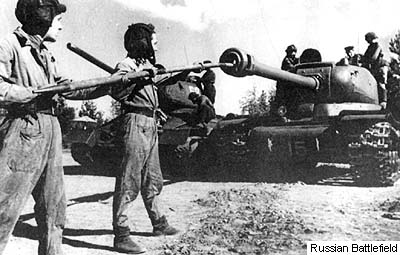 Clearing the gun after fighting. |
Moreover, one tank was evacuated and taken away for rebuilding and the Regimental repair crew repaired other five damaged tanks.
From the middle to the end of May 1944, the Regiment was incorporated into the 18th Army, which participated in defensive actions against enemy counterattacks south-east of Stanislav.
From June 1944 to the end of the war, the Regiment was incorporated into the 4th Tank Army. The Regiment took part in the Lvov-Sandomirs, Nizhne-Silezskaya, Verkhne-Silezskaya, Berlin, and Prague offensive operations. For the liberation of Lvov, the Regiment was honored with the name "Lvovskiy". For military services during the war the Regiment was decorated with the Orders of Red Banner, Suvorov 3rd grade, Kutuzov 3rd grade, Bogdan Khmelnitsky 2nd grade and Alexander Nevsky.
Despite the fact that the career of 71st Independent Guards Heavy Tank Regiment, equipped with the JS-2s, was not so remarkable, it still deserves special attention. In August 1944, the Regiment, together with 6th Guards Tank Corps, participated in the defeat of Konig Tiger battalion on the Sandomirs bridgehead.
The best source of what happened is the Report about operations of the 71st Independent Guards Heavy Tank Regiment.
JS-2's and Tigers I and II engaged only occasionally. For example, in November 1944, there was a battle where several JS-2's were involved in close battle with German tanks of the 503rd PzAbt (near the Budapest, Hungary). A larger battle occurred on 12 January of 1945 during the Visla-Oder offensive operation: a column of Konig Tigers of the 524th PzAbt was involved in close combat with Soviet tanks near Lysov. Both sides suffered heavy losses.
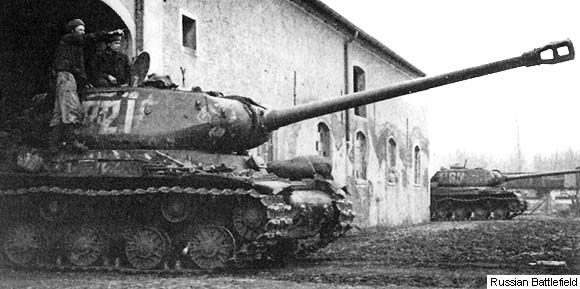
It is important to remark that the Germans weren't able to access and analyze the JS-2 for quite a long time. That was because the Russians were in control of the battlefields. Such a case happened only in May of 1944 near the Rumanian town of Tigru-Frumos. From December 1944, formation of new Independent Guards Heavy Tank Brigades was begun. Usually they were based on existing Tank Brigades which were equipped with the T-34-85. First of all, these new groups were formed to overcome well-prepared German defences and, in additional, for successful combat with German tank units. According to the TO&E, each of the new Independent Guards Heavy Tank Brigade consisted of three heavy tank regiments, one motorised SMG infantry battalion, and support units such as signals, medical, etc. The total strength of an Independent Guards Heavy Tank Brigade was 1,665 men, sixty five JS-2 tanks, one light SP battery of three SU-76M, nineteen lend-lease M3 half-tracks and three armored cars. In total, five Independent Guards Heavy Tank Brigade were formed. Two of them - the 7th and 11th - took part in the Berlin Operation. At the end of the war, each Tank Corps should have at least one Tank Regiment of JS-2 tanks, which were best for breaking through a heavily entrenched enemy line. A single 122 mm shot could penetrate the armored cupola of a concrete bunker, or shatter the main redbrick walls of the Konigsberg. At that time, an infantryman with a Faustpatrone, a Panzerfaust, or even a Panzerschreck, became the most dangerous enemy of the JS-2. Russians didn't distinguish these weapons and called them all "faust". Thus, an infantryman with a "faust" was called a "faustnik". During street fighting, about 70% of destroyed tanks were hit by "fausts". From the beginning of 1945 Soviet tanks received shields of various designs. These shields were intended to protect from HEAT munitions (e.g. "fausts"). Most of these shields only protected turret, whilst hull remained unprotected. That was not so bad, as many people think now, because over 80% of "faust" hits were on the turret side. A shaped-charge round would completely destroy the shield, but leave the main armor unbreached, leaving a small black hole in it. Soviet tankers called such holes as "the kiss of the witch". Unfortunately, these shields might be torn off by a shell, or explosion. The result could be fatal. Lieutenant-Colonel V.Mindlin (a participant of battles for Berlin) wrote in his memoirs "The Last Battle - the Hard Battle!" about this: |

"Here is a tank with battened down hatches... but the crew is silent. They respond to neither radio nor knock. There is a small hole with a diameter no more than a cent. That was a "faust", that was its work. A shield was torn off, and a next round penetrated the armor...
Those who saw a tank battle knew how terrible death could be for tankers. If a round hit the ammunition or fuel tanks, a tank would be destroyed at once - just blast off and the crew perishing without any torture.
Often a round just penetrates the tank's armor but doesn't hit the ammunition or fuel tanks. All crewmembers are wounded, their tank is burning, but the crew is unable to extinguish the flame. They need to escape the tank and run off to a safe distance. However, the tankers are wounded and they simply can't do that, they can't open the locked hatches. And you can hear the cries of those being burned alive. You can't help them because the hatches are locked inside..."
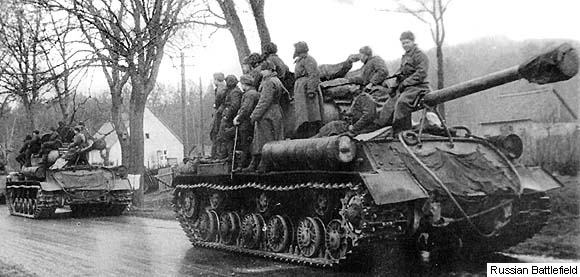
It was very dangerous to fight with open hatches (and prohibited, by the way) because enemy infantry could throw a grenade into a tank. Thus, all crews received an order to close hatches but not to lock them. As a result the losses crew were reduced. For better performance in street fighting, the Russians used a special formation called "elochka" (a fir-tree). A tank platoon (4 tanks) was divided into two pairs. The first pair moving on both sides of a street (the first tank on the left side, the second - on the right) in order to destroy any targets. This pair is covered by the second pair which moved towards them and protect them with additional gunfire until the first pair reload their guns. Each tank company was supported by one infantry platoon. They protected their tanks from "faustniks". Additionally, special assault troops were formed. They consisted of one SMG platoon supported by a gun, usually a 76 mm regimental or divisional gun. Michael Badigin mentioned those troops in his memoirs. DShK heavy machine-guns were very useful against enemy infantry. Unfortunately, they caught on tram-wires, so some crews dismounted these MGs before entering the cities. |
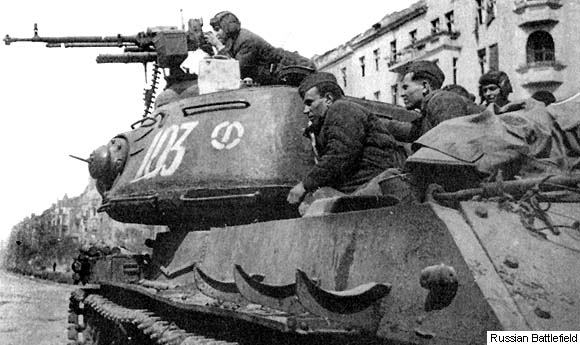
Besides the Red Army, the JS-2 served in the Polish Army (Voisko Polskoe) - there were 71 tanks in the 4th and 5th Heavy Tank Regiments. During battles in Pomerania, the 4th Heavy Tank Regiment destroyed 31 enemy tanks and lost only 14 tanks. Both regiments took part in the battle for Berlin. Poles planned to form another two regiments - 6th and 7th - but the war ended, so that plan was abandoned. At the end of the war, the Poles had 26 JS-2 heavy tanks; they returned 21 tanks to the Red Army. The remaining 5 tanks served in the Polish 7th Tank Regiment. In the spring of 1945, just before the liberation of Prague, the Czech Army received several JS-2's. In the beginning of the 1950's, several JS-2 heavy tanks were sent to China. According to some documents, during the Korean war, Chinese volunteers used them against the Americans. Unfortunately I was unable to verify this. American intelligence spotted at least four Chinese independent tank regiments. Each regiment consisted of four companies of T-34-85's and one company of JS-2's (five tanks). |
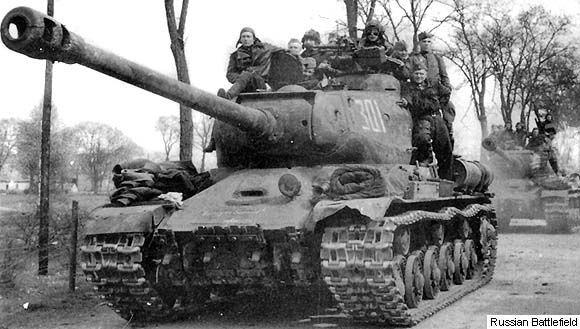
During the war in Indo-China, French forces met with JS-2's which had been sent from China to Vietnam. A single ex-German Panther was sent to Vietnam for trials and to counter the JS-2 tanks, but it got mired in the jungle. At the same time, some JS-2's were sent to North Korea. Two Korean tank divisions had one heavy tank regiment each. In the Soviet Army, the JS-2M served for a very long time. They survived the later JS-3 and JS-4. They were supposed to be replaced with the T-10, but that did not happen. In the 1970's, they were used in the Far East fortified sectors as pillboxes. The last time the JS-2M tank was used was in 1982 in the Odessa Military District during manoeuvres. However, the official order to remove the JS-2 from service was only issued in 1995! I doubt that an unsuccessful tank could serve for such a long time! All German tanks and projects were abandoned much earlier, it is important to keep in mind during the absurd (but still very popular) "best tank of..." debates. |
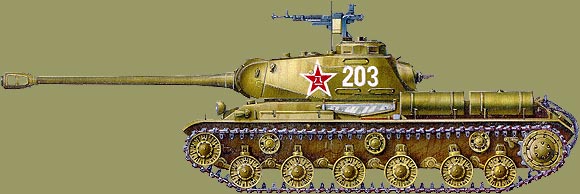
Proof-reader:
Chris Amundson Sources: "JS heavy tank", Manual, 1944 "A short technical report about the improving the armoring of the JS", NII-48, Sverdlovsk, 1944 "Studying the JS tanks being destroyed in summer-autumn 1944", NII-48, Sverdlovsk, 1945 "From the experiense of usage a tanks during the Great Patriotic War. Part one", 1946 "Heavy tanks and SP guns in action", NKTP, 1945 "About the tactic of the heavy tanks and SP guns during the street fighting", Handbook, 1945 M.Svirin "The JS tanks", Armada #6, 1998. |